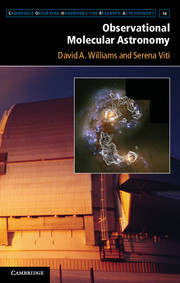Book contents
- Frontmatter
- Contents
- List of Illustrations
- List of Tables
- Preface
- 1 Introduction
- 2 Spectra and Excitation of Interstellar Molecules
- 3 Astrochemical Processes
- 4 Physical Processes in Different Astronomical Environments
- 5 Molecular Tracers in the Milky Way Galaxy
- 6 Molecular Tracers in External Galaxies
- 7 The Early Universe and the First Galaxies
- 8 Recipes for Molecular Submillimetre Astronomy
- 9 Chemical and Radiative Transfer Models
- 10 Observations: Which Molecule, Which Transition?
- Appendix: Acronyms
- Index
- References
6 - Molecular Tracers in External Galaxies
Published online by Cambridge University Press: 05 December 2013
- Frontmatter
- Contents
- List of Illustrations
- List of Tables
- Preface
- 1 Introduction
- 2 Spectra and Excitation of Interstellar Molecules
- 3 Astrochemical Processes
- 4 Physical Processes in Different Astronomical Environments
- 5 Molecular Tracers in the Milky Way Galaxy
- 6 Molecular Tracers in External Galaxies
- 7 The Early Universe and the First Galaxies
- 8 Recipes for Molecular Submillimetre Astronomy
- 9 Chemical and Radiative Transfer Models
- 10 Observations: Which Molecule, Which Transition?
- Appendix: Acronyms
- Index
- References
Summary
The first detections of molecular emissions from species such as CO and HCN in external but relatively nearby galaxies were made in the 1970s. From the 1990s, detections were made of CO emission from high-redshift objects, culminating in the remarkable identification in 2003 of high-excitation CO in a gravitationally lensed quasar at a redshift of 6.4. At that time, this was the most distant quasar known. In standard cosmology a redshift of 6.4 represents material when the Universe was merely a few percent of its present age. The discovery of molecular emission in such a distant object demonstrated that chemistry was occurring very early in the evolution of the Universe, and its products – molecules – must therefore also be widespread. In more recent years, it has been firmly established that chemistry in external galaxies can be complex and well developed. So the question arises: Can we use molecular emissions from distant galaxies to explore the physical conditions in them and their likely evolutionary status, as we can do for various regions of the Milky Way (cf. Chapter 5)?
There are a couple of points to be borne in mind, before simply applying the ideas in Chapter 5 to external galaxies. The most important one is that – apart from the nearest objects – most galaxies will be spatially unresolved; the telescope beam will usually encompass the entire galaxy being observed, so that emissions from many types of region are compounded. However, the detection of, say, CO, SiO, and CH3OH emissions in a spatially unresolved galaxy does not mean that they occur in the same region of that galaxy: the first molecule may indicate the presence of cold tenuous clouds, the second strong shocks, and the third dense star-forming cores. External galaxies will, in general, contain the variety of regions and sources similar to those that we can identify in the Milky Way.
- Type
- Chapter
- Information
- Observational Molecular AstronomyExploring the Universe Using Molecular Line Emissions, pp. 99 - 127Publisher: Cambridge University PressPrint publication year: 2013



